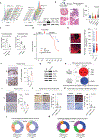Transcriptional-translational conflict is a barrier to cellular transformation and cancer progression
- PMID: 37084735
- PMCID: PMC10208629
- DOI: 10.1016/j.ccell.2023.03.021
Transcriptional-translational conflict is a barrier to cellular transformation and cancer progression
Abstract
We uncover a tumor-suppressive process in urothelium called transcriptional-translational conflict caused by deregulation of the central chromatin remodeling component ARID1A. Loss of Arid1a triggers an increase in a nexus of pro-proliferation transcripts, but a simultaneous inhibition of the eukaryotic elongation factor 2 (eEF2), which results in tumor suppression. Resolution of this conflict through enhancing translation elongation speed enables the efficient and precise synthesis of a network of poised mRNAs resulting in uncontrolled proliferation, clonogenic growth, and bladder cancer progression. We observe a similar phenomenon in patients with ARID1A-low tumors, which also exhibit increased translation elongation activity through eEF2. These findings have important clinical implications because ARID1A-deficient, but not ARID1A-proficient, tumors are sensitive to pharmacologic inhibition of protein synthesis. These discoveries reveal an oncogenic stress created by transcriptional-translational conflict and provide a unified gene expression model that unveils the importance of the crosstalk between transcription and translation in promoting cancer.
Keywords: ARID1A; MAP kinase; RASGRP1; SWI/SNF; bladder cancer; eEF2; eEF2K; homoharringtonine; transcription; translation elongation.
Copyright © 2023 The Author(s). Published by Elsevier Inc. All rights reserved.
Conflict of interest statement
Declaration of interests The authors declare no competing interests.
Figures







Similar articles
-
mTORC1 Promotes ARID1A Degradation and Oncogenic Chromatin Remodeling in Hepatocellular Carcinoma.Cancer Res. 2021 Nov 15;81(22):5652-5665. doi: 10.1158/0008-5472.CAN-21-0206. Epub 2021 Aug 24. Cancer Res. 2021. PMID: 34429326 Free PMC article.
-
Short-Term Memory Impairment.2024 Jun 8. In: StatPearls [Internet]. Treasure Island (FL): StatPearls Publishing; 2025 Jan–. 2024 Jun 8. In: StatPearls [Internet]. Treasure Island (FL): StatPearls Publishing; 2025 Jan–. PMID: 31424720 Free Books & Documents.
-
Arid1a deficiency sensitises pancreatic cancer to fatty acid synthase inhibition.Clin Transl Med. 2025 Jul;15(7):e70394. doi: 10.1002/ctm2.70394. Clin Transl Med. 2025. PMID: 40621620 Free PMC article.
-
A rapid and systematic review of the clinical effectiveness and cost-effectiveness of paclitaxel, docetaxel, gemcitabine and vinorelbine in non-small-cell lung cancer.Health Technol Assess. 2001;5(32):1-195. doi: 10.3310/hta5320. Health Technol Assess. 2001. PMID: 12065068
-
Single-incision sling operations for urinary incontinence in women.Cochrane Database Syst Rev. 2017 Jul 26;7(7):CD008709. doi: 10.1002/14651858.CD008709.pub3. Cochrane Database Syst Rev. 2017. Update in: Cochrane Database Syst Rev. 2023 Oct 27;10:CD008709. doi: 10.1002/14651858.CD008709.pub4. PMID: 28746980 Free PMC article. Updated.
Cited by
-
Vitamin K2 Alleviates Insulin Resistance Associated Skeletal Muscle Atrophy via the AKT/mTOR Signalling Pathway.J Cachexia Sarcopenia Muscle. 2025 Jun;16(3):e13840. doi: 10.1002/jcsm.13840. J Cachexia Sarcopenia Muscle. 2025. PMID: 40464168 Free PMC article.
-
Chromatin remodeling and cancer: the critical influence of the SWI/SNF complex.Epigenetics Chromatin. 2025 Apr 23;18(1):22. doi: 10.1186/s13072-025-00590-w. Epigenetics Chromatin. 2025. PMID: 40269969 Free PMC article. Review.
-
Transcriptional-translational conflict: a novel exploitable tumor suppressive mechanism.Signal Transduct Target Ther. 2023 Sep 25;8(1):361. doi: 10.1038/s41392-023-01591-5. Signal Transduct Target Ther. 2023. PMID: 37743426 Free PMC article. No abstract available.
-
Frequency and Nature of Genomic Alterations in ERBB2-Altered Urothelial Bladder Cancer.Target Oncol. 2024 May;19(3):447-458. doi: 10.1007/s11523-024-01056-x. Epub 2024 Apr 3. Target Oncol. 2024. PMID: 38570422
-
Elongation factor 2 in cancer: a promising therapeutic target in protein translation.Cell Mol Biol Lett. 2024 Dec 20;29(1):156. doi: 10.1186/s11658-024-00674-7. Cell Mol Biol Lett. 2024. PMID: 39707196 Free PMC article. Review.
References
-
- Marcel V, Ghayad SE, Belin S, Therizols G, Morel AP, Solano-Gonzalez E, Vendrell JA, Hacot S, Mertani HC, Albaret MA, et al. (2013). p53 acts as a safeguard of translational control by regulating fibrillarin and rRNA methylation in cancer. Cancer cell 24, 318–330. 10.1016/j.ccr.2013.08.013. - DOI - PMC - PubMed
-
- Yang HS, Jansen AP, Komar AA, Zheng X, Merrick WC, Costes S, Lockett SJ, Sonenberg N, and Colburn NH (2003). The transformation suppressor Pdcd4 is a novel eukaryotic translation initiation factor 4A binding protein that inhibits translation. Mol Cell Biol 23, 26–37. 10.1128/mcb.23.1.26-37.2003. - DOI - PMC - PubMed
Publication types
MeSH terms
Substances
Grants and funding
LinkOut - more resources
Full Text Sources
Medical
Molecular Biology Databases
Miscellaneous

